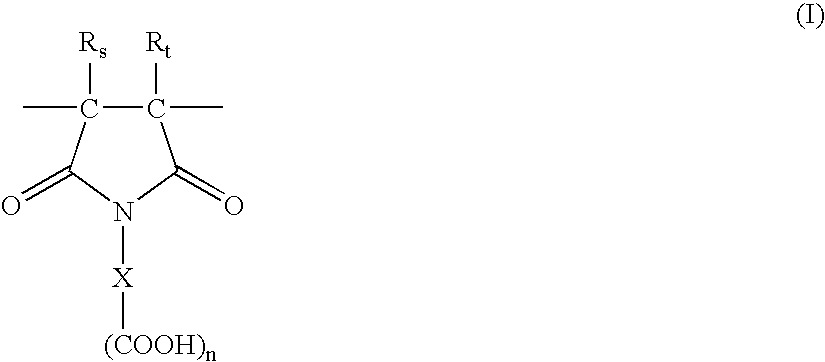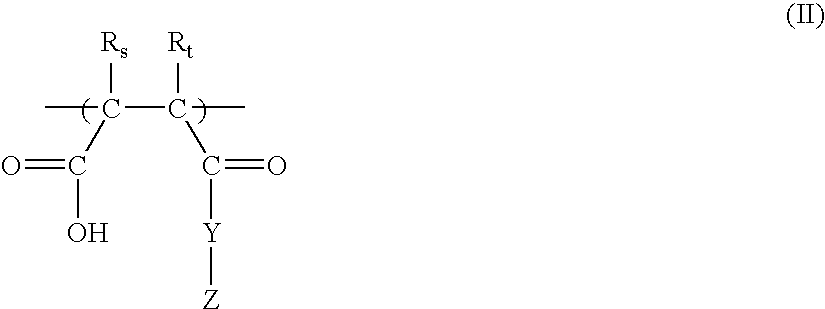Multilayer imageable element with improved chemical resistance
a multi-layer imageable element and chemical resistance technology, applied in the field of positive working imageable elements, can solve the problems of time-consuming process and small change in mask dimensions, and achieve the effect of improving chemical resistan
- Summary
- Abstract
- Description
- Claims
- Application Information
AI Technical Summary
Benefits of technology
Problems solved by technology
Method used
Image
Examples
example 1
[0182]A positive-working imageable of this invention was prepared as follows. An inner layer formulation (6% solids) was prepared by dissolving the following components shown in TABLE I in a solvent mixture comprising MEK (45%), PMA (35%), BLO (10%), and water (10%).
[0183]
TABLE IInner Layer ComponentParts by weightPolymer A84.5IR Dye A15Byk ® 3070.5
[0184]This inner layer formulation solution was coated on Substrate A and dried at 135° C. for 45 seconds to provide a dry coating weight of 1.3 g / m2.
[0185]An upper layer formulation was prepared with Copolymer 2 (2.4 g), Byk® 307 (0.012 g) and Ethyl Violet (0.013 g) that were dissolved in 20 g of a solvent mixture of DEK and Dowanol PM (9:1 weight ratio) and coated over the dried inner layer to provide a dry outer layer coating weight of 0.65 g / m2.
[0186]The thermally imageable element thus formed was dried at 135° C. for 45 seconds. The element was imaged with test patterns at 9W and drum speeds between 150 rpm and 360 rpm in steps of 30...
example 2
[0188]A positive-working imageable of this invention was prepared as follows. An inner layer formulation (6% solids) was prepared by dissolving the following components shown in TABLE II in a solvent mixture comprising MEK (45%), PMA (35%), BLO (10%), and water (10%).
[0189]
TABLE IIInner Layer ComponentParts by weightPolymer B84.5IR Dye A15Byk ® 3070.5
[0190]This inner layer formulation solution was coated on Substrate A and dried at 135° C. for 45 seconds to provide a dry coating weight of 1.35 g / m2.
[0191]An upper layer formulation was prepared with Copolymer 1 (2.4 g), Byk® 307 (0.012 g) and Ethyl Violet (0.013 g) that were dissolved in 20 g of a solvent mixture of DEK, Dowanol PM, and isopropyl alcohol (8:1:1 weight ratio) and coated over the dried inner layer to provide a dry outer layer coating weight of 0.55 g / m2.
[0192]The thermally imageable element thus formed was dried at 135° C. for 45 seconds. The element was imaged with test patterns at 9W and drum speeds between 150 rpm a...
example 3
[0194]A positive-working imageable of this invention was prepared as follows. An inner layer formulation (6% solids) was prepared by dissolving the following components shown in TABLE III in a solvent mixture comprising MEK (45%), PMA (35%), BLO (10%), and water (10%).
[0195]
TABLE IIIInner Layer ComponentParts by weightPolymer A59.5Polymer C15.0GP resole10.0IR Dye A15Byk ® 3070.5
[0196]This inner layer formulation solution was coated on Substrate A and dried at 135° C. for 45 seconds to provide a dry coating weight of 1.35 g / m2.
[0197]An upper layer formulation was prepared with Copolymer 2 (2.4 g), Byk® 307 (0.012 g) and Ethyl Violet (0.013 g) that were dissolved in 20 g of a solvent mixture of DEK, Dowanol PM, and isopropyl alcohol (8:1:1 weight ratio) and coated over the dried inner layer to provide a dry outer layer coating weight of 0.60 g / m2.
[0198]The thermally imageable element thus formed was dried at 135° C. for 45 seconds. The element was imaged with test patterns at 9W and d...
PUM
| Property | Measurement | Unit |
|---|---|---|
| mol % | aaaaa | aaaaa |
| mol % | aaaaa | aaaaa |
| mol % | aaaaa | aaaaa |
Abstract
Description
Claims
Application Information
 Login to View More
Login to View More - R&D
- Intellectual Property
- Life Sciences
- Materials
- Tech Scout
- Unparalleled Data Quality
- Higher Quality Content
- 60% Fewer Hallucinations
Browse by: Latest US Patents, China's latest patents, Technical Efficacy Thesaurus, Application Domain, Technology Topic, Popular Technical Reports.
© 2025 PatSnap. All rights reserved.Legal|Privacy policy|Modern Slavery Act Transparency Statement|Sitemap|About US| Contact US: help@patsnap.com



